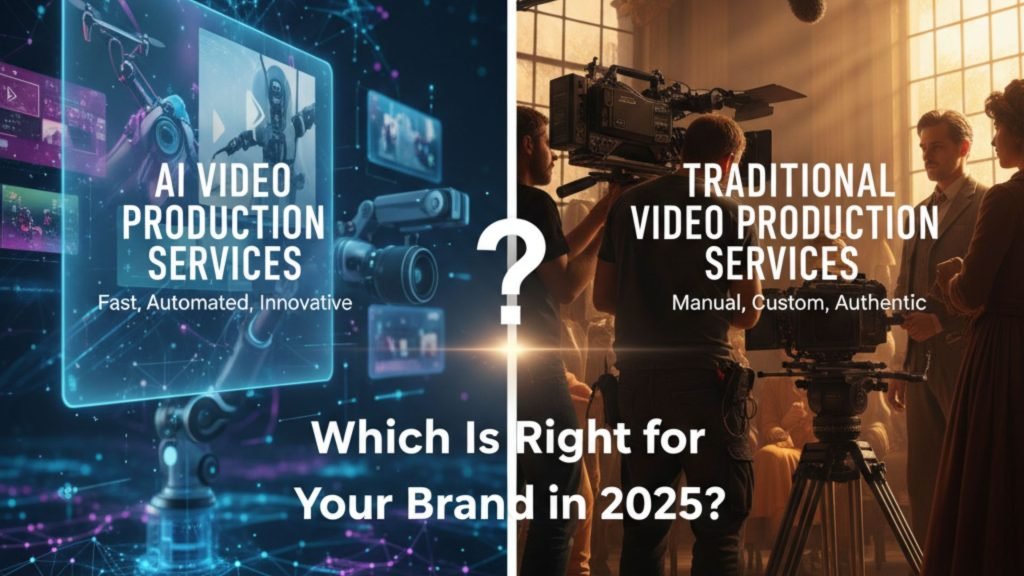
Video has become the backbone of modern marketing. In 2025, 89% of businesses use video as part of their marketing strategy, and 95% of marketers say video is “crucial” to their overall strategy.
With such widespread adoption, the methods of creating video content are evolving rapidly, especially driven by advances in artificial intelligence. This blog will compare AI video services with traditional video production, helping you decide which approach is best for your brand’s needs—based on factors like speed, cost, creativity, and scalability.
What Are AI Video Production Services?
AI video services leverage AI tools, algorithms, and automation to handle many of the tasks previously done by human crews. This includes script-to-video conversion, voice synthesis, avatar or virtual presenter creation, automated editing, multilingual versions, and more. In essence, you feed in a script or concept, and the system handles much of the production pipeline.
This model works especially well for use cases that require rapid output, multiple versions, localization, and cost efficiency. It’s ideal when you want to generate many short videos (for training, internal communications, product explainers, social media) rather than one big flagship film.
What Is Traditional Video Production
Traditional video production is the “classic” method: filming real actors or presenters, on location or in a studio, with a full production crew (director, camera operator, lighting, sound, editors). Post-production includes manual editing, color grading, possible VFX, and sound mixing.
This approach allows for rich visual storytelling, high production values, authenticity (real people, real environment), and deep creative control. It’s broadly used for brand films, commercials, documentaries, live events, and high-impact storytelling where emotion, nuance, and craftsmanship matter.
Key Comparison: AI Video vs Traditional Production
Here’s a side-by-side comparison of how each approach stacks up across core criteria:
| Criteria | AI Video Production | Traditional Video Production |
|---|---|---|
| Production Speed | Very fast – often days rather than weeks | Longer timelines – weeks to months |
| Cost | Significantly lower, starting at ₹10,000 (fewer crew, no studio overhead) | Higher cost (crew, equipment, location) |
| Scalability / Volume | Limited by budget, logistics, and resource constraints | Explainers, training videos, social media, high-volume content, localization |
| Customisation & Creative Depth | Excellent – can generate many versions quickly, localize easily | Very high—custom visuals, real actors, bespoke sets and creative direction |
| Emotional Storytelling / Authenticity | Moderate – virtual presenters/avatars may lack full human nuance | Strong – real people, real environments, rich emotional baggage |
| Best For | Customization & Creative Depth | Brand films, TVCs, immersive storytelling, flagship assets |
For example, many recent reports indicate that companies leveraging AI video tools can achieve 70–90% cost savings compared to traditional production, especially when deploying high-volume or multi-language assets. (Based on industry analyses.)
Moreover, the conversion uplift from video in general is significant: websites featuring video content report higher conversion rates vs those without.
Speed, Cost & Scalability – Why It Matters
Speed
In the digital economy, speed often equals competitive advantage. If you can take an idea and turn it into a video in hours or a couple of days, you’re better able to respond to market trends, internal training needs or social-media opportunities. AI video services excel here.
Cost
Traditional video costs remain high: crew, actors, locations, equipment, travel, shoots, and edits. AI workflows reduce many of these costs by automating parts of the process and eliminating heavy production overhead. That allows even mid-size businesses to build robust video pipelines.
Scalability
If your business needs many videos (multiple languages, versions, A/B-testing, internal training, short-form social clips), AI becomes increasingly attractive. Traditional production tends to scale poorly unless you have a large budget and infrastructure.
Creativity & Storytelling – Where Traditional Holds Strong
While AI video services now produce impressive results, the creative and emotional depth of a traditional production remains hard to match. Real people, real emotion, dynamic locations, cinematic lighting—these elements contribute to brand storytelling that resonates.
Reports highlight that although AI has grown in usage (for example, some sources say ~41% of marketers are using AI in video production processes).
However, such tools still complement rather than replace human-led creative direction when nuance, authenticity, and brand identity are critical.
Use-Cases: Which Approach for What Scenario?
When AI Video Services Make Sense
- You need quick turnaround of videos (product demos, training modules, internal comms)
- You’re delivering content in multiple languages/locales and need efficient localization
- You have social media campaigns needing many variants for different channels
- Budget is moderate, and you want value, consistency, and repeatability
When Traditional Production Makes Sense
- You’re creating a flagship brand film, commercial, or documentary-style asset
- Authenticity matters: real actors, on-location shots, human emotion, brand history
- Video is a major part of a high-budget campaign where production value is a differentiator
Hybrid Approach
Increasingly, brands adopt a hybrid model: using AI video for volume, localization, and speed; using traditional production for flagship, high-impact pieces.
Why Trigital Solutions Is Your Expert Partner
At Trigital Solutions, we specialize in AI Video Services, enabling organizations to leverage automation, speed, and cost efficiency without compromising on brand quality. Whether you’re producing explainers, training videos, product demos, or social-first content, our workflow brings:
- Rapid turnaround time
- Affordable video production services starting at ₹10,000
- Brand consistent visuals and voice across formats
- Multi-language and scalable output
- Strategic consultation to choose the right approach (AI vs traditional or hybrid)
We help clients build video pipelines that are future-ready—so you can keep pace with the evolving demands of video marketing while maintaining quality and impact.
Conclusion
Video is no longer optional—in 2025, it’s central to marketing and brand communication. With 89% of businesses using video and 95% of marketers calling it crucial, the pressure is on to choose the right production approach.
If your objective is speed, scalability, and cost-efficiency, AI video services are a smart choice. If your goal is deep storytelling, cinematic quality and brand immersion, traditional production remains the gold standard. And if you want both, a hybrid strategy offers the best path forward.
By understanding these differences and aligning them with your business needs, you can deploy video content that drives engagement, conversions and brand strength. With the right partner and approach, video becomes not just production, but a strategic advantage.
Frequently Asked Questions (FAQs)
Q1. Are AI-generated videos as effective as traditionally produced ones?
They are highly effective for many types of content—especially when speed, volume, and localization matter. But for deeply emotional storytelling, traditional production still has the upper hand.
Q2. What typical costs are involved in AI video production?
Costs vary depending on length, localization, and customization. AI services often start at significantly lower budgets than traditional shoots, which can run into hundreds of thousands. The precise pricing depends on the scope.
Q3. How quickly can an AI video be delivered?
In many cases, in days rather than weeks, because you skip large parts of the manual production pipeline.
Q4. Can AI videos include real people, presenters, or brand ambassadors?
Yes—many AI workflows allow virtual avatars, voice-over integrations, and branded elements. If you need real-people footage, a hybrid or traditional route might be necessary.
Q5. How do I decide between AI video, traditional video, or a hybrid?
Evaluate your goals: turnaround time, budget, story complexity, localization needs, and volume. Choose AI for scale and speed; choose traditional for high-impact, high-emotion storytelling; consider hybrid when you need both.
Sources of stats used in this article
www.webfx.com/blog/marketing/video-marketing-statist
www.siegemedia.com/strategy/video-marketing-statistics
www.wyzowl.com/video-marketing-statistics/


